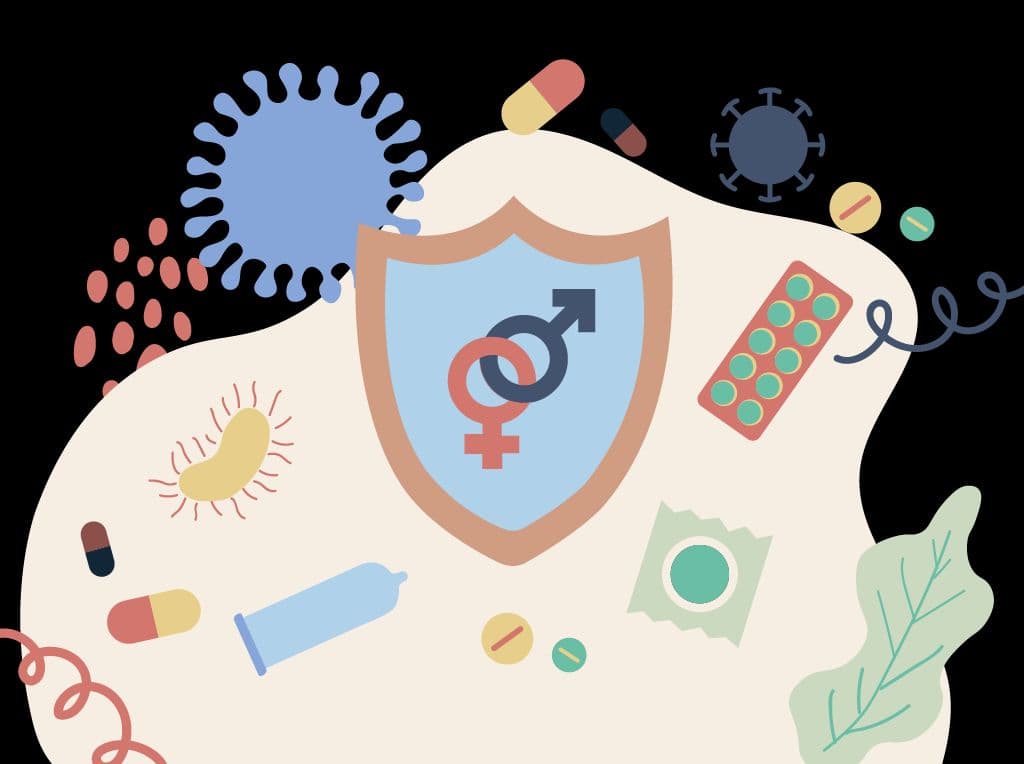What are IUDs?
An intrauterine device (IUD), also known as an intrauterine contraceptive device (IUCD or ICD), or a coil, is a small, T-shaped birth control device implanted into the uterus to prevent pregnancy. IUDs are a type of reversible long-acting birth control. IUDs, along with other contraceptive implants, have the highest level of patient satisfaction among birth control techniques. IUDs are safe and successful for both teens and those who have never had children before. Fertility quickly returns to normal when an IUD is removed, even if it has been used for a long time.
What are the benefits of IUDs?
There are numerous advantages to using an IUD. Let’s look at some of them -
- Effectiveness, longevity, and convenience are the main reasons
- IUDs do not require preparation before intercourse
- Can be used while breastfeeding
- IUDs are fast reversible if you want to become pregnant
- They are not expensive after the first cost of insertion and there are no additional charges for 3 to 10 years
What are the types of IUDs?
IUDs types can be categorised into 2 - hormonal and non-hormonal.
Non-hormonal IUDs have a copper coating on a T-shaped device that is the same size as your uterus and takes up the same amount of space when implanted. They are also known as Copper Ts.
Hormonal IUDs include hormones that are released in a set dose every day through the device. For many women, IUDs are an excellent method of birth control. They are not, however, the ideal option for women who are at a high risk of sexually transmitted illnesses (STIs).
How do these devices provide contraception?
The copper released from the device produces an inflammatory reaction in the endometrium (inner lining of the uterus) which makes the environment adverse for sperm motility and survival. Also, it interferes with the implantation of the fertilized egg thus preventing pregnancy. The copper IUD’s inflammation also alters the motility of fallopian tubes (which carry the egg) thus hampering the meeting of egg and sperm.
While, hormones present in the hormonal IUDs cause a progestogenic effect on the endometrium, making them not suitable for implantation of a pregnancy. These hormones released from the IUD make the mucus at the cervix (mouth of the uterus) thicker and thus prevent sperms from entering the uterus.

How to pick what is right for you?
Hormonal IUDs: Hormonal IUDs work by thickening the cervical mucus, weakening the uterine wall, and preventing sperm from binding to the egg. Not only is fertilisation unlikely, but even if fertilisation happens, the chances of implantation are slim. The hormone doses for each hormonal IUD are different. They each emit a bigger dose of the hormone at first, which gradually diminishes over time. Even as the delivered dosage decreases, the device continues to prevent conception for the length of usage. Each type is only suggested for a specific amount of time, usually three to five years. Because hormonal IUDs include progestin, you may notice a reduction in menstrual flow. For example, you might spot for a few months and then have lighter and shorter periods after that. It's also possible that your period will cease entirely, which is deemed safe. For women who have heavy blood flow during periods or irregular periods with heavy flow, Hormonal IUDs are the best choice for them as it reduces the flow of blood during periods along with providing contraception.
Non-hormonal IUDs: are made of polyethene in copper wire and work in a completely different way. It prevents pregnancy by causing an inflammatory reaction to copper, which destroys the egg, affects sperm motility and viability, and reduces an egg's capacity to implant even if fertilised. They are the ones that can be used for the longest time, up to ten years. The copper IUD will not affect the time of your menstrual cycle because it is hormone-free. It may, however, produce heavier periods with greater cramps or back pain than usual, particularly in the first few menstrual cycles after it is implanted. Non-hormonal IUDs contain copper and are more frequently used than hormonal IUDs. Non-hormonal IUDs also have many varieties such as multiload, Cu 375, and Cu 250 according to the surface area of copper. For women who seek a contraceptive method for a longer duration than non-hormonal IUDs, these are the best choice for them. They are easy to insert and remove and are also cheaper than hormonal IUDs.
What is the cost of getting an IUD?
IUD contraceptives vary according to the type of IUD. It can cost from Rs 200 to Rs 1000 in India. Hormonal IUDs have a higher cost, and they can range from Rs 5000 to Rs 10000 in India.
Are there any side effects when you use IUDs?
Yes, there are side effects to using IUDs. You may expect any of the following:
- Headaches
- Nausea
- Acne
- Mood swings
- Breast tenderness
- Depression
- Decreased libido
- Hair loss
- Ovarian cysts
- Spotting between periods
- Abdominal pain
- Heavy periods or even no periods at all
- Weight gain
How long does an IUD last?
Non-hormonal IUDs have a life varying from 3 years to 10 years according to the type.
Hormonal IUDs have a life of 5 years.
Who can get an IUD?
IUDs are safe contraceptive options for people in their teenage years and in their 20s who have not carried a child. It is best for menstruators:
- who seek a long term contraceptive method
- who want to have a space between two pregnancies
- who have certain chronic disorders such as clotting disorders
- who can't go for hormonal pills as contraceptive methods
It is considered the best choice for those who want immediate postpartum contraceptives. They can go for a special Postpartum IUD. Non-hormonal IUDs are also used as a mode of emergency contraception. It can be inserted within 5 days or 120 hours of unprotected intercourse. It prevents implantation of the fertilised ovum and thus prevents pregnancy after unprotected intercourse. Please ensure that you make an informed decision after consulting your gynaecologist.
Are there situations where gynaecologists can refuse to insert an IUD?
Yes, your gynaecologists may refuse to insert IUDs in any of the situations below:
- If there is some infection in the uterus, this infection can flare up and spread to other parts of the genital organs after inserting IUD
- If there is continuous bleeding through the vagina and the cause of which is unknown if the menstruator has genital cancer
- If the menstruator Is already pregnant if the uterine cavity is distorted, the IUD cannot be placed accurately.
- If the menstruator has an active vaginal infection.
How to check if the IUD is in the proper place?
To check if your IUD is in place:
- Wash your hands thoroughly with soap and water.
- Place your finger into your vagina until you touch your cervix.
- Feel for the string ends.
The string should be able to be felt. There could be an issue if the string feels shorter or longer than usual. You should not be able to feel the IUDs hard end touching your cervix.
Do not pull on the string or attempt to reinsert the IUD yourself if there is a problem. Make an appointment with your doctor instead. They can see if the IUD is in good condition and what the state of the string is.
Expulsion is a rare occurrence. If it occurs, it will most likely occur with your period. Expulsion is most likely to happen within the first several months of implantation. Use an alternative form of contraception while you wait for the IUD to be reinserted.
What Are the similarities Between IUD Types?
Copper Ts and hormonal IUDs both work by interfering with sperm motility. They prevent sperm from contacting the egg. IUDs of both types are equally effective. Although each variety of IUDs offers various levels of protection against pregnancy, they can all be removed at any time. If you decide you wish to get pregnant or are unhappy with the adverse effects, removal is always a choice.
What to Expect During and After an IUD Insertion?
The insertion of the IUD into your uterus through your vagina and cervix is done using an applicator by your gynaecologist. A gynaecologist takes around 10 minutes. There is a chance you may experience cramping or dizziness. IUDs have a string attached to them which makes it easy for you to check their placement inside your uterus. The string makes its removal easier as well.
You may develop temporary side effects after insertion of an IUD such as:
- menstrual-like cramps
- a backache
- heavier than normal periods
- spotting between periods
- irregular periods
In very rare cases you may develop shifting, or expulsion of IUD, and even perforation of the uterine wall.
Bottom Line
Just like any contraceptive method, you need to understand the risks and benefits of the IUDs and make an informed decision. Consult your doctor and make the final decision. Consider the cost, effectiveness, side effects, durability, and reversibility before you choose an IUD suitable for you. If this method does not work for you, your doctor will help you zero in on the best option. Remember, parenthood is always a choice.
Disclaimer - This information is educational and should not be construed as medical advice. Please consult your doctor before making any dietary changes or adding supplements.
Proactive For Her is a digital clinic for women, offering accessible, personalised, and confidential healthcare solutions. We offer out-patient care, diagnostic services and programs for various health concerns of Indian women, across their lifetime - from puberty to pregnancy to menopause.

